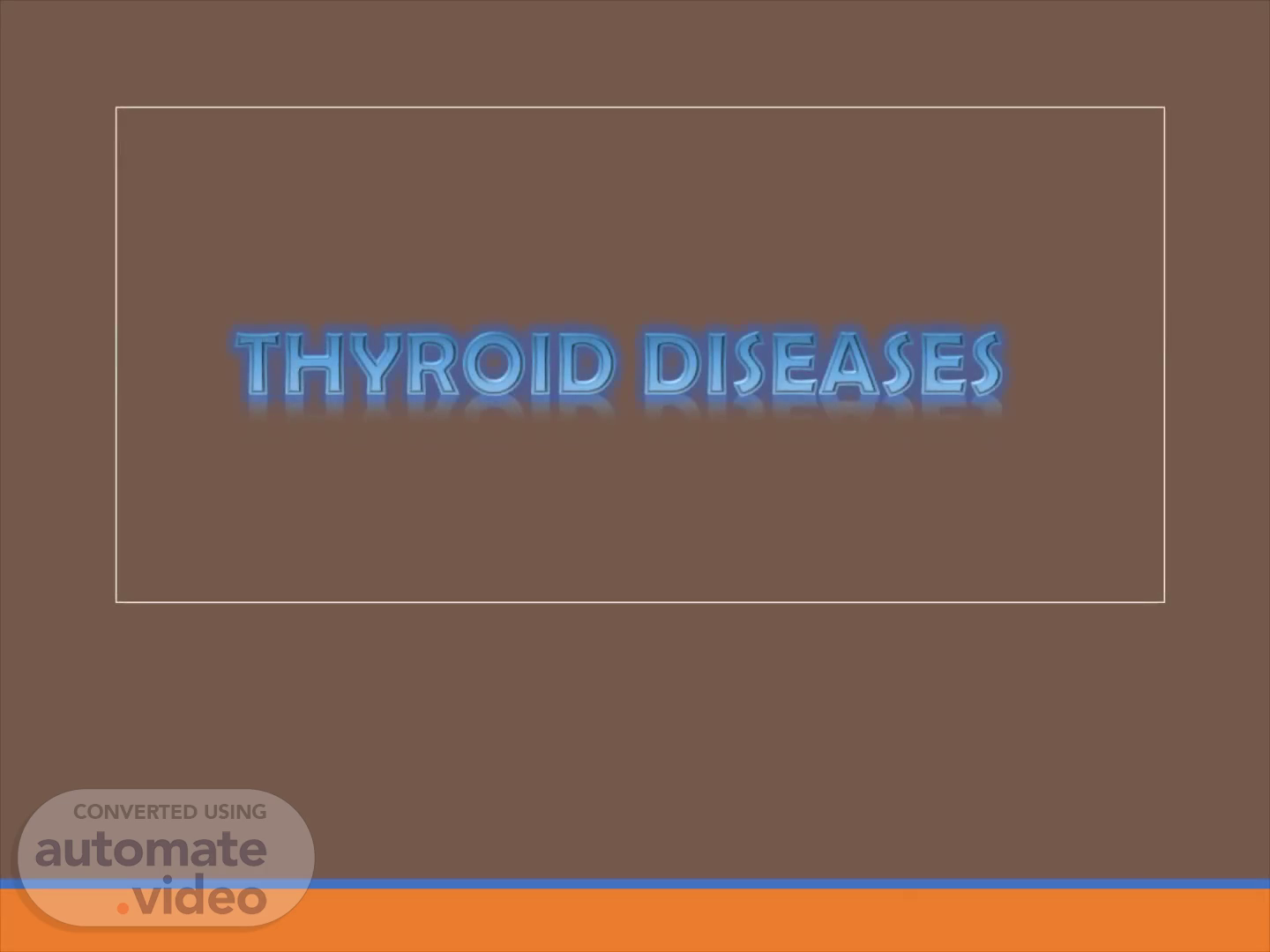Scene 1 (0s)
THYROID DISEASES. BY: V.HEMASHREE PHARM-D IInd year.
Scene 2 (7s)
INTRODUCTION Largest endocrine gland. Located inferior to cricoid cartilage. Butterfly shaped organ comprising of two lobes - lobus dexter(right) - lobus sinister(left) Weighs 18-60gms in adults. Histologically it is made up of follicular and parafollicular cells..
Scene 3 (20s)
Blood supply Arterial supply - superior thyroid artery - inferior thyroid artery Venous supply - superior thyroid vein - inferior thyroid vein Nerve supply - Superior laryngeal nerve Recurrent laryngeal nerve Lymphatic drainage - Lateral deep cervical lymph node - Pretracheal/para tracheal lymph nodes.
Scene 6 (43s)
Physiology Hypothalamus Thyroid releasing hormone(TRH) Pituatary Thyroid stimulating hormone(TSH) Thyroid gland (target site) Tyrosine(target hormone) MIT/DIT.
Scene 7 (50s)
Regulation of T 3 and and other stressors Secre t i on S ti tory ibitory portal systern Anterior pituitary Thyroid gland TSH and in target tissues: roetab01isrn • Increase body ternperature Increase norrna' oro•wtt• and devoloprnent.
Scene 8 (1m 0s)
THYROID DISORDERS • GRAVE'S DISEASE • THYROID STORM HYPERTHYROIDISM • TOXIC THYROID NODULE • HASHIMOTOS THYROIDITIS • CRETINISM • MYXOEDEMA HYPOTHYROIDISM • POSTPARTUM THYROIDITIS • SUBACUTE THYROIDITIS • SICK EUTHYROIDISM.
Scene 10 (1m 15s)
THYROTOXICOSIS Hypermetabolic clinical syndrome resulting from serum elevation of thyroid hormone levels(T3 & T4). Causes are GRAVE' S disease, multinodular goitre and toxic adenoma. GRAVE'S DISEASE is the most common form..
Scene 11 (1m 26s)
GRAVE'S DISEASE Introduction Autoimmune disease. KNOW ABOUT AUTOIMMUNE DISEASE Female : Male ratio — 5:1 or 10:1 Has a strong hereditary component. Diagnosis is mainly made by the symptoms.
Scene 12 (1m 36s)
Signs and symptoms Skin is warm and moist, palms are warm,moist and hyperemic and Plummer's nails are seen. Pretibial myxedema. Alopecia and vitiligo. Severe cases proptosis maybe seep Excessive sweating and heat intolerance. CVS symptoms: palpitations, CCF, isolated systolic hypertension. Metabolic symptoms: weight loss despite of increased in apetite..
Scene 13 (1m 53s)
GIT symptoms: hyperdefecation. Exacerbate bronchial asthma. CNS symptoms: nervousness, irritability, tremor, insomnia, proximal muscle weakness. In females: amenorrhea/ oligomenorrhea. o In males: impotence and loss of libido..
Scene 15 (2m 12s)
Management Immediate control: Propranolol 40mg/6hr orally. Long term control: Anti thyroid drugs — Carbimazole 15mg tid initially and then reducing it to 5mg tid for 12-18 months. Radio iodine ablation — Postmenopausal women and elderly men. In recurrence following surgery. Given to fertile women conception postponed to 1 year. Surgery — Presence of large goitre. Poor drug compliance..
Scene 17 (2m 35s)
MULTINODULAR GOITRE Excess production of thyroid hormones from functionally autonomous thyroid nodules which do not require the stimulation from TSH. Second common cause. Occurs in individual over 60 years of age and females are mostly affected..
Scene 18 (2m 47s)
ThYToid rx dulc Symptoms Nortnal thyrtUd glmd Large goitre with or without tracheal compression. Goitre is nodular or lobulated, often palpable. Large goitre cause mediastinal compression with stridor, dysp obstruction of superior vena ca Hoarseness.
Scene 20 (3m 4s)
THYROID STORM Rare but life threatening sudden severe exarcerbation of hyperthyroidism. Causes: Precipitated by stress or infection with either unrecognized thyrotoxicosis or inadequately treated thyrotoxicosis. Following subtotal thyroidectomy/radio active iodine. Trauma. Pregnancy. Emotional stress..
Scene 22 (3m 22s)
Management Treatment started immediately with Propranolol 80mg/6hrs orally(dose of 1-5mg/6hrs given IV). Potassium iodide 60mg daily orally/ sodium iopodate 500mg daily orally. Carbimazole 60-120mg daily Dexamethasone 2mg/6hrs IV. Fluid replacement. Antibiotics..
Scene 23 (3m 36s)
HYPOTHYROIDISM Insufficiency synthesis of thyroid hormones. Female : Male ratio is 6 : 1. Causes : Hashimoto's thyroiditis Thyroid failure following radio iodine. surgical treatment of thyrotoxicosis. Drugs like carbimazole, amiadarone. Iodine deficiency..
Scene 24 (3m 49s)
SIGNS AND SYMPTOMS. Fatigue Increased sensitivity to cold Constipation Dry skin Weight gain Puffy face Hoarseness Muscle weakness Heavier than normal or irregular menstrual periods Thinning hair Slowed heart rate.
Scene 26 (4m 6s)
Signs and symptoms Weight gain. Enlarged thyroid gland. Depression. Sensitivity to heat/cold. Fatigue. Hypoglycemia. Increased cholestrol level. tn%oftåbcmng.
Scene 29 (4m 27s)
CRETINISM Hypothyroidism dating from birth. Tyroxine is essential for growth and development of brain during the first three years. Earlier onset greater is the brain damage. Causes : - Congenital developmental defects. - Radio iodine/surgery. - Post radiation. - Iodine deficiency. Drug induced. - Hashimoto's thyroiditis. - Recurrent hypothyroidism..
Scene 30 (4m 43s)
Signs and symptoms Dry, cool, mottled skin, hoarse cry, broad flat nose, puffy face. Protruberant abdomen, umblical hernia, hypotonia. Large posterior fontanelle. Lethargy, delayed stooling, poor feeding/sucking. Cold to touch. Delayed dentition. Mental retardation..
Scene 31 (4m 58s)
Management Investigation : Cord blood T4, TSH. Serum T4, TSH RAIU X-ray of knee, foot and skull. Treatment Medication : levothyroxine (initial dose of 10- 15mcg/kg/dl). Diet : iodine rich foods. Follow up..
Scene 32 (5m 12s)
MYXOEDEMA Severe hypothyroidism in which there is accumulation of hydrophilic mucopolysaccharides in the skin and other tissues. Common in women. Two variants — Hyperthyroid myxoedema — Hypothyroid myxoedema. Cause : Increased deposition of glycosamine glycans Hashimoto's thyroiditis..
Scene 33 (5m 24s)
MYXOEDEMA COMA Uncommon but life threatening form of untreated hypothyroidism with physiological decompensation. Occurs in patients with long standing hypothyroidism. Precipitated by a climate induced hypothermia, infection, drug therapy and other systemic conditions.
Scene 35 (5m 41s)
Investigations Free T4 and TSH T3 & T4 levels are decreased and TSH are elevated or normal. Serum electrolyte and serum osmolality. Serum creatinine. Serum glucose. Differential blood count. Pan culture for sepsis..
Scene 36 (5m 53s)
Treatment Hyperventilation if respiratory acidosis is significant. Immediate IV levothyroxine given Loading dose of 500 - 800mcg followed by 50 — 100mcg daily. Hydrocortisone 5 — 1 Omg/hr. Treatment of associated infection. Correction of hyponatremia with saline. Correction of hypoglycemia with IV dextrose..
Scene 37 (6m 8s)
Thyroid tests T3, T4 and TSH levels. Presence of TPO antibodi ) Thyroid scan. Thyroid uptake test..
Scene 38 (6m 17s)
Thyroidectomy Surgical removal of all or a part of the gland. Indications: Thyroid carcinoma. Hyperthyroidism. Very enlarged thyroid. Symptomatic obstruction..
Scene 39 (6m 27s)
Complications Hypothyroidism. Laryngeal nerve injury. Hypoparathyroidis Infection. Chyle leak. Surgical scar..
